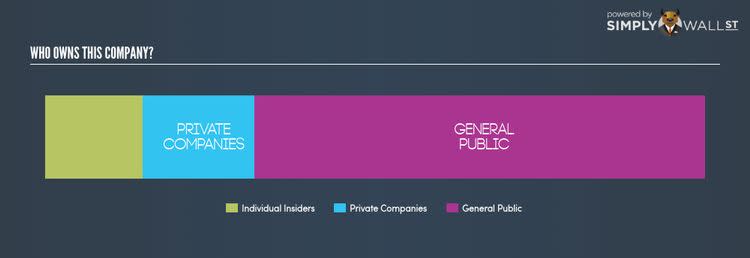Who Are The Largest Shareholders In Cerus Energy Group Ltd (TSXV:CEA)?

In this article, I’m going to take a look at Cerus Energy Group Ltd’s (TSXV:CEA) latest ownership structure, a non-fundamental factor which is important, but remains a less discussed subject among investors. The impact of a company’s ownership structure affects both its short- and long-term performance. Since the effect of an active institutional investor with a similar ownership as a passive pension-fund can be vastly different on a company’s corporate governance and accountability of shareholders, investors should take a closer look at CEA’s shareholder registry. All data provided is as of the most recent financial year end.
View our latest analysis for Cerus Energy Group
Insider Ownership
Insiders form another group of important ownership types as they manage the company’s operations and decide the best use of capital. Insider ownership has been linked to better alignment between management and shareholders. 14.86% ownership of CEA insiders is large enough to make an impact on shareholder returns. In general, this level of insider ownership has negatively affected underperforming (consistently low PE ratio) companies and positively affected the companies that outperform (consistently high PE ratio). It’s also interesting to learn what CEA insiders have been doing with their shareholdings lately. While insider buying is possibly a sign of a positive outlook for the company, selling doesn’t necessarily indicate a negative outlook as they may be selling to meet personal financial needs.
General Public Ownership
A substantial ownership of 68.21% in CEA is held by the general public. This size of ownership gives retail investors collective power in deciding on major policy decisions such as executive compensation, appointment of directors and acquisitions of businesses. This level of ownership gives retail investors the power to sway key policy decisions such as board composition, executive compensation, and potential acquisitions. This is a positive sign for an investor who wants to be involved in key decision-making of the company.
Private Company Ownership
Another important group of owners for potential investors in CEA are private companies that hold a stake of 16.93% in CEA. These are companies that are mainly invested due to their strategic interests or are incentivized by reaping capital gains on investments their shareholdings. An ownership of this size indicates a strong financial backing and has the potential to influence CEA’s business strategy. Thus, investors should dig deeper into CEA’s business relations with these companies and how it can affect shareholder returns in the long-term.
What this means for you:
Are you a shareholder? A relatively significant holding of company insiders could mean high alignment with shareholders. But at the same time, investors should be aware of the level of influence executives could have on governance decisions. If you’re looking to diversify your holdings with high-quality stocks, our free analysis platform has a selection of high-quality stocks with a strong growth potential.
Are you a potential investor? Ownership structure should not be the only determining factor when you’re building an investment thesis for CEA. Instead, you should be evaluating fundamental factors like the relative valuation of CEA, which is an important driver that determines CEA’s share price. Take a look at our most recent infographic report on CEA for a more in-depth analysis of these factors to help you make a more well-informed investment decision.
NB: Figures in this article are calculated using data from the last twelve months, which refer to the 12-month period ending on the last date of the month the financial statement is dated. This may not be consistent with full year annual report figures.
To help readers see pass the short term volatility of the financial market, we aim to bring you a long-term focused research analysis purely driven by fundamental data. Note that our analysis does not factor in the latest price sensitive company announcements.
The author is an independent contributor and at the time of publication had no position in the stocks mentioned.

